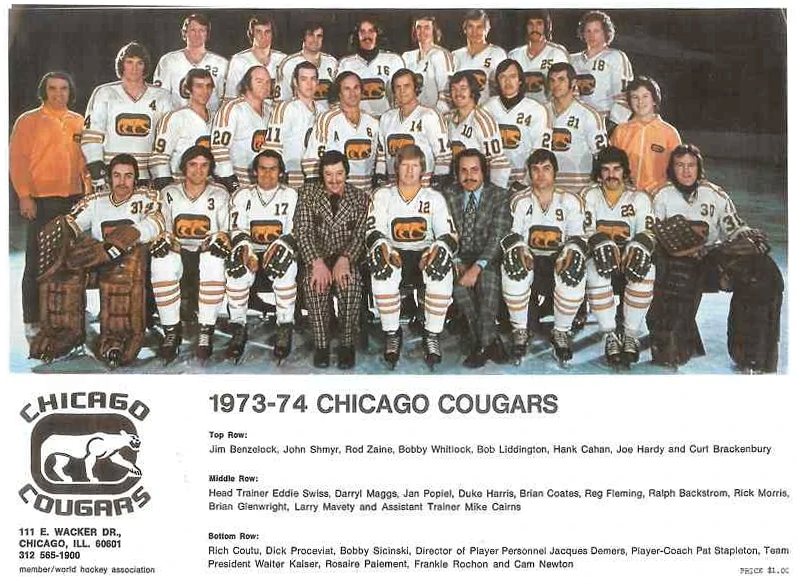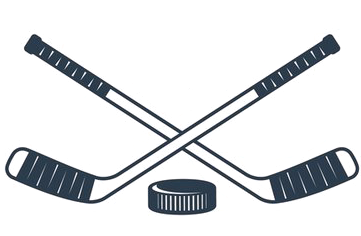
MOST TIMES it is impossible to believe the unbelievable. Like the Cougars.
Virtually ignored because they were projected as the least likely to succeed, they now are on the last chapter of the second most stunning story in Chicago sports annals—second only to the 1938 Black Hawks, the “underest” of underdogs, a 1,000-to-zero shot that won the Stanley Cup and literally besmirched the image of hockey.
Like the Cougars, that Hawk club won because they had “seven hockey players and a bunch of guys who wanted to win no matter what.” And that historic quote came from John Gottselig, one of the “seven,” 36 years ago. And by comparison, because of circumstances and situations, the Cougar chances of a successful final chapter are very much higher. They tottered on the brink of success all season, peaking unbelievably in the last 20 games.
The 1938 Hawks stumbled thru the entire season, winning only 14 games, finishing sixth in a seven-team league and then backing into the playoffs when team No. 7, the Detroit Red Wings, lost their final game of the regular season.

In the playoffs against the Montreal Canadiens, New York Americans, and the Toronto Maple Leafs, the Hawks won seven more games and the Cup. But the minute details of the bizarre happenings dispatched to the Tribune by George Strickler were so unbelievable that Arch Ward, the late sports editor, refused to publish them. Ward later apologized to Strickler.
BUT THE COUGARS you must believe, now. Their hope of success is more than wishful thinking as the Tawny Tabbies, the Cinderellas of hockey, the Orphans, the amazing, the surprising Cougars tonight attempt to weave more substance into their impossible dream—succeeding where the Cubs, White Sox, Black Hawks, Bulls, and Bears have failed. A sports championship, at long last, for Chicago.
They open the World Hockey Association playoff finals at Randhurst—the shopping center series—against the Houston Aeros, admittedly the best club in the league mostly because of the Howe family, Pappa Gordie and sons Mark and Marty.
They can do it because of a couple of old pros [Player-Coach Pat Stapleton, and Ralph Backstrom, the tireless river skater] have the Cougars high, playing better hockey than they know how [“I hope that last part isn't true,” commented Stapleton].
But it is true, and the fact dates to the Cougars' last home game of the regular season. It was the “must win” game against the Jersey Knights that qualified the team for the playoffs.

Pat and Ralph virtually lived on the ice the first two periods, scrambling fore and aft magnificently. They were determined the Cougars were not going to lose, and their emotional drive infected the other players. They finally eased up in the third period when the contagion clinched it with a 7-1 lead that melted to a final 7-3 verdict.
And the contagion spread into a huge emotional binge that has engulfed fandom and developed into the Cinderella story. The Cougars just couldn't lose, coming from behind against the New England Whalers in the quarterfinals, and then repeating the semifinals against the Toronto Toros.
DURING THAT SPREAD, the Cougars did expose problems getting the puck out of their own end zone, and some ineptness in center ice. But in the attack zone they suddenly became big leaguers, forechecking hard and deep in the corners where games are won or lost—knocking 'em down, taking the puck away from them and slamming it down their throats. That is the hallmark of Boston's Burpin' Bruins and Philadelphia's Broad Street Bullies, who now are battling for the Stanley Cup.
That rock 'em, sock 'em approach also was the Hawk success formula in 1938, the worst Hawk team in history that contained eight American-born players and a Boston-born coach, Bill Stewart, who refereed hockey in the winter and umpired baseball in the summer.
He was selected by the late owner, Maj. Frederic McLaughlin, for fiery spirit displayed during a Cubs-St. Louis Cardinal game in Wrigley Field during midsummer of 1937. Steward exploded and cleared the “Gas House Gang” bench which had been riding him over a third called strike against Joe [Ducky] Mcdwick.
Stewart opened the Hawk training sessions that fall in the Lawson Y. M. C. A. Think that's funny? Here are just a few of the bizarre happenings during the playoffs that saved the Hawks from elimination.
In the deciding game of the Canadien series, a team they hadn't beaten during the regular season, Gottselig almost killed the Hawks by scoring a goal for the foe. But minutes later he came up with the winner on a pass from Paul Thompson.

AGAINST THE AMERICANS, Doc Romnes registered the decisive goal, but Dr. Albert Suprenant of Montreal, the goal judge, never did blink the red light because a couple of New York fans had the doctor pinned down away from the button. Referee Clarence Campbell, now the league president, had to rule it a score.
Goalie Mike Karakas came out of that game with a broken toe. As a replacement, the Hawks sought permission to use Dave Kerr, the Ranger goalie, in the finals. They received tentative approval from Conn Smythe, Toronto's major domo, and Frank Calder, the league president, on the morning of the opening game, April 5, 1938. But one hour before game time, the Hawks were informed they had to use Alfie Moore, a minor leaguer with the Pittsburgh Hornets.
Moore, out of condition and very high after an afternoon-long session at the hotel bar, refused angrily. And Stewart, invading the Toronto locker room for a violent protest, was tossed out bodily and bloodied by Smythe and his aide, Baldy Cotton.
The victims of the intrigue, including Moore, all of whom now were fighting mad, went out on the ice and registered the first big upset of the playoffs, a 3-1 score. The goalie story had leaked out into the stands, and the Toronto fans booed their Maple Leafs and cheered the Hawks, some helping in carrying off the hero, Moore, who now was decorated with a new name—English Arf ‘n' Arf Alfie.

THIS INFURIATED the Leafs, who, in the second game against Goalie Paul Goodman, the Hawk spare recalled from Winnipeg, blasted the Hawks 5-1 and wrecked them physically. Seven players were in the Garfield Park Hospital, when the Hawks returned to Chicago. And among them was Rom-nes, the little center, whose nose was broken by Red Horner, the league's bad man.
But all the Hawks showed up for the third game in the Stadium, including 18,496 fans, then the largest crowd ever to see a game anywhere.
Romnes, protecting his nose with a face mask, vowed to “get Horner.” And he did with a two-handed swipe of his stick at the opening face-off. Campbell, the referee, said later “it missed by three feet,” but Horner went down and Trainer Tim Daly was dispatched with the smelling salts.
Romnes' stick swipe not only intimidated Horner, but also finished his mates. And the Toronto Maple Leafs, a vastly superior team, lost the next two games and the Stanley Cup to a team, like the Cougars, that just reftfsed to lose.
By Ted Damata
